
Jay County, Indiana, is bounded on the north by Adams and Wells Counties, on the east by Mercer and Darke Counties, Ohio, on the south by Randolph County, and on the west by Delaware and Blackford Counties. The area of the county is 377 square miles, or 241,692 acres. In 1860, the population was 11,378, and in 1870, was 14,979.
Jay County was created by an act of the Indiana General Assembly on February 7, 1825, and organized by a law of January 30, 1826, effective March 1, 1826. On December 5, 1835, the Board of Commissioners ordered “that the County Seat of Jay County be designated and known by the name of Portland.”
The county was organized by another act which was passed and approved on January 30, 1837. It was divided into the following twelve townships: Wabash, Bearcreek, Jackson, Penn, Knox, Greene, Wayne, Noble, Madison, Pike, Jefferson, and Richland.
By an act of the Indiana legislature on January 25, 1843, Portland was incorporated as a town. In 1883, it was incorporated as a city.
The county was named for John Jay, the first Chief Justice of the United States Supreme Court. It is the only Jay County in the United States.
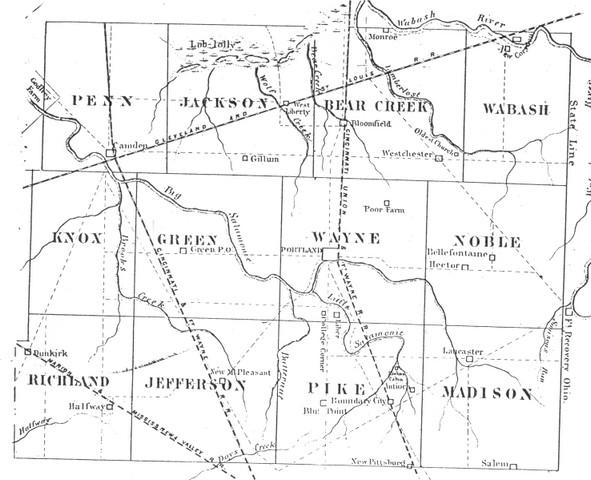
On their wedding night in 1821, Peter and Mary Studabaker, who had been wed in Fort Recovery, Ohio, settled on the south bank of the Wabash River, at what is now New Corydon, Jay County. Here Peter built a crude cabin of small round logs, the first dwelling erected in the county. There was no other house within thirty-five miles. Their son, Abram, was born in the little cabin on September 29, 1822, making him the first white person born in Jay County. Because the Wabash flooded frequently and the wolves attacked their animals, the Studabakers soon moved back to Fort Recovery, Ohio.
John and Mary Brooks and their daughter, Nancy, were the second family of pioneers to come to Jay County, and the first permanent settlers. In November, 1823, they and John Gain, a Dutch Indian trader, left Ridgeville in a wagon pulled by oxen. The first night, they camped on the bank of a small creek in what is now Knox Township. The creek was named Brooks Creek in their honor.
The next morning, they went on to the Indian village and then crossed the Salamonie River to a spot three-fourths of a mile away where Mr. Gain had built two log cabins, one for a home, the other for a trading post. Mr. Gain had offered to pay Mr. Brooks $60 a year if he would bring his family here and keep house for him.
After almost two and a half years, they moved back to Brooks Creek where they had camped that first night. This was only twelve miles from Ridgeville and became their permanent home.
Other pioneers then began settling near them and in other parts of what would become Jay County.
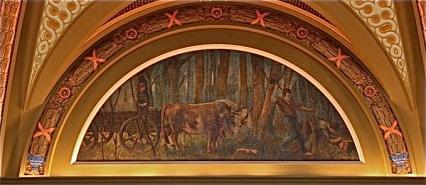
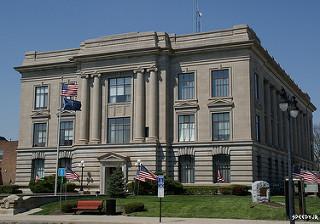
The present Jay County Courthouse, located in West Main Street in Portland, is the fourth one which has served the county. The cornerstone was laid in 1916, with construction being completed in 1919. The structure is made mostly from Bedford limestone and marble. It has 104 windows and four sets of brass doors.
The link below will treat you to a slideshow tour of this beautiful building. After opening the link, click on “show info” in the supper right corner and text will describe what you are seeing. You may stop and start the show at will.
http://www.flickr.com/photos/becca3k/sets/72157604477506965/show/
(Thanks to Rebecca James for providing this slide show and many of the other photographs on our website to us. Follow our link to “Rebecca James Photography” to enjoy hundreds of wonderful Jay County pictures.)
Bryant, a community of about 275 people, is located seven miles north of Portland on Highway 27 in Bearcreek Township. It was first called “Billtown” because the town was begun on the four corners of land owned by four men named Bill. On December 8, 1871, the town was platted as “Bryan” to recognize Mr. Bryan, who was a construction foreman on the railroad and was influential in getting a railroad there. The railroad company did not like the name and changed the station to “Briant.”
Another town, North Briant was laid out north of Briant on October 6, 1873. It was also called “Rowley Town” after Ezekiel Rowlett, who laid it out.
In December of 1897, Briant and North Briant were incorporated as “Bryant,” the spelling of which was chosen by the post office.
Bryant was a bustling railroad town during the oil boom. By 1910, it had a population of 465 and 32 businesses. When the oil boom ended, the workers moved away. The railroad has since been abandoned, leaving Bryant with very few businesses.
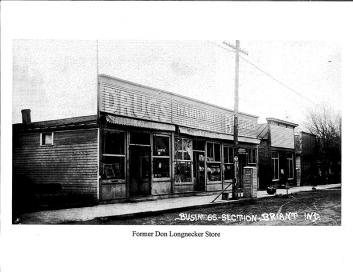
Dunkirk is situated on Highway 167 in the far southwest corner of Richland Township. It is unique because a portion is in Blackford County, and Delaware County begins as the southern line of Dunkirk. Dunkirk is the second largest community in the county.
The Isaiah Sutton and William Shrack families settled there in half-faced log cabins in October, 1837. Isaiah’s cabin was up first, so the settlement was called “Sutton Town” for many years.
In December, 1853, with a railroad being proposed, Isaiah platted “Quincy,” a little town of three blocks, on his land. When the railroad arrived in 1857, they called their station “Dunkirk” even though it was in Quincy.
When a government post office was requested, there was already a Quincy, but the post office accepted the name of “Dunkirk.” Then Mr. Sutton requested his little community’s name be changed to Dunkirk.
Because Dunkirk is on the “crown” or top of a rock structure which trapped natural gas, it also has the nickname of “Crown City.”
Dunkirk is also known as “The Glass Capital of Indiana” because it was once home to several glass factories. The only remaining glass factory produces over two million beer bottles daily. The Glass Museum, on South Franklin Street, has over 6,500 pieces of glassware from 110 factories around the world on display, including glassware produced in the former local factories.
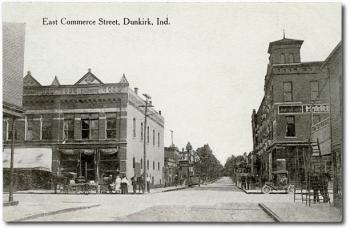
Pennville is in the northwest corner of the county on Highway 1 in Penn Township. This community has had more names than any other in the county. In 1836, Samuel Grissell platted a little village a short distance from his farm and named it “New Lisbon. A year later, he changed the name to “Camden.” In the beginning, it was the largest town in Jay County and almost became the county seat. But, because it wasn’t near the center of the county, that did not happen.
Many years later, when applying for a government post office, the name had to be changed because there was already a Camden. Because many Quakers had settled in the area, “Penn” was chosen in honor of William Penn. But, due to careless handwriting, Penn was often confused with “Peru.” So, Penn was changed to “Pennville” to solve that problem.
In 1907, Dr. Charles Caylor opened his own little private hospital, which he called the Provident Hospital, in Pennville. But in 1917, Dr. Caylor closed his hospital because the railroad no longer came through there and patients could not easily travel to Pennville. He then opened a larger hospital in Bluffton, Indiana, that was called the Caylor-Nickel Clinic.
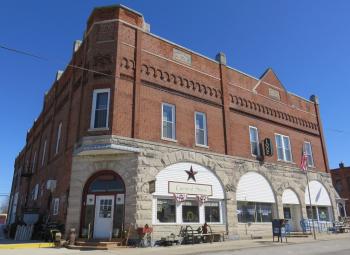
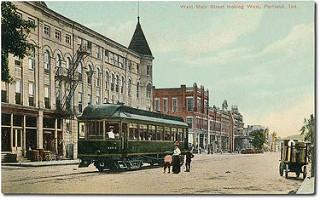
Portland is the county seat of Jay County and is in Wayne Township. It is the only community that has retained its original name, being planted and named in 1837, by Dr. Daniel W. McNeal. The growth of Portland was gradual, with only 300 residents in 1850. After the first train arrived in Portland on November 4, 1871, the town grew rapidly. By 1887, 2,500 people had settled in Portland.
In 1887, Portland had the first successful natural gas well in the state of Indiana. This brought much business to Portland and Jay County, including several glass factories at Redkey and Dunkirk. Life became better for most citizens during the Gas Boom period.
Portland is recognized for its concrete Bowstring Arc/Arch Bridge that crosses the Salamonie River on South Meridian Street. It was built in 1914 and restored in both 1976 and 1997, and is the only bridge of its kind remaining in Indiana.
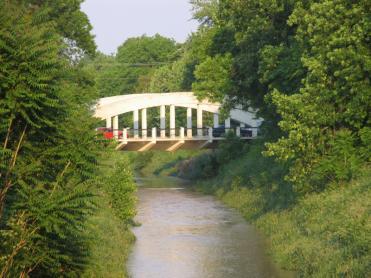
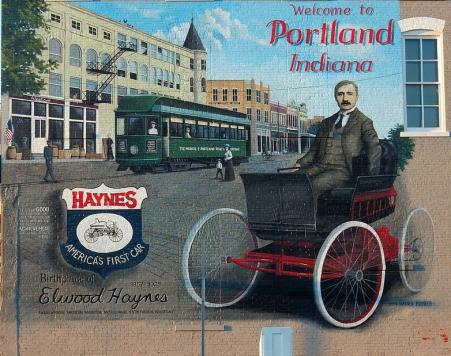
The Jay Community Resource Center, across from the post office on South Meridian Street, is home to a 1910 Elwood Haynes automobile. Elwood was born in Portland in 1857, at the southwest corner of Commerce and High Streets. A plaque there touts him as “the inventor, designer, and builder of America’s first successful automobile.” A mural on the side of the former Merchant’s Hotel Building on North Meridian Street honors Mr. Haynes.
The former Art Deco Weiler Brothers’ Department Store, at the southeast corner of Main and Meridian Streets, was designed by Jay County native Walter Scholer and constructed in 1926. After being vacant for several years, renovation of the structure began in 2006 and was completed in 2008. The facility, now known as the John Jay Center for Learning, offers many choices for education beyond high school which may not otherwise be possible for area residents.
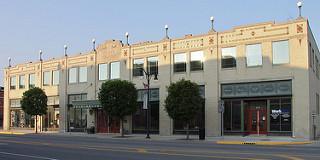
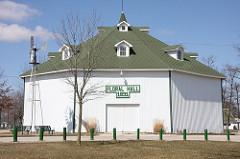
The Jay County Fairgrounds, located on East Votaw Street, is a well-kept facility which is home to the Jay County Fair in July, the Tri-State Gas Engine and Tractor Show in August, and many other activities throughout the year. Floral Hall, a round building built in 1891, is on the National Record of Historic Buildings.
Portland is home to two museums. The Museum of the Soldier is located in the former Coca-Cola Bottling Company building on East Arch Street and displays a large assortment of military memorabilia. The Jay County Historical Museum, located at the end of East Main Street, has thousands of artifacts of Jay County’s history, along with a large genealogy library.
Redkey is located southwest of Portland at the crossroads of Highways 1 and 67 in Richland Township.
In 1836, the Josiah Wade family bought 80 acres of land along a little steam called Halfway Creek. Mr. and Mrs. Wade and five of their married children formed a little community known as “Wade Settlement.”
William Harrison Wade platted a section of his land in 1854, which became “Mount Vernon.” On December 2, 1856, Rev. James Redkey bought a farm at the edge of Mount Vernon from William H. Wade. Since the railroad was coming, Rev. Redkey had the land platted in lo9ts which could be added to Mount Vernon. The surveyor used the name Redkey for his plat. When the railroad came, the train station was called Redkey. Then in 1867, Mount Vernon became known as Redkey.
Redkey’s main industry was the CAAR Canning Company, which canned mostly tomatoes. The town has several historic buildings, including an opera house and a flatiron building along the railroad tracks. John Shambarger’s restaurant, which closed in the 1980s, attracted guests from all over the world.
Today, Redkey has a very active group of citizens who are working to restore the downtown area and open various types of shops which will attract visitors to the community.
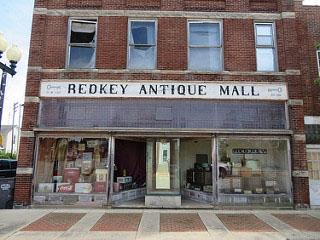
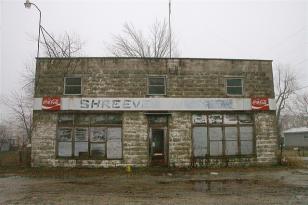
Salamonia is in Madison Township, southeast of Portland on 800 E and 400 S.
The town of “Lancaster” was laid out in 1839 by Henry Abel and Benjamin Goldsmith. However, because there was already a post office with that name, the town was named “Salamonia.” It was incorporated in March of 1867.
Salamonia’s 1911 brick schoolhouse, where school was held until 1924, has been restored as a community center.
Volunteers at the Jay County Historical Museum provide educational tours for students. Third graders in the Jay School Corporation, who study Jay County history, visit the museum annually. Other classes and groups are encouraged to tour the museum.
The Heritage Festival each year provides many educational experiences for children and adults alike. (See “Current” and “Past” Heritage Festivals.)
Informational packets about Jay County are provided to students nationwide upon request.
A Journey Through Time, the textbook used by third graders in the Jay School Corporation, is available for purchase at the museum. Other historical books are also available here.
903 E Main St.
Portland, Indiana 47371
Phone: 260-726-7168
| Su | Mo | Tu | We | Th | Fr | Sa |
| 01 | 02 | 03 | 04 | 05 | 06 | |
| 07 | 08 | 09 | 10 | 11 | 12 | 13 |
| 14 | 15 | 16 | 17 | 18 | 19 | 20 |
| 21 | 22 | 23 | 24 | 25 | 26 | 27 |
| 28 | 29 | 30 | 31 |
